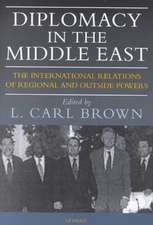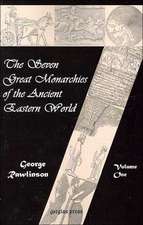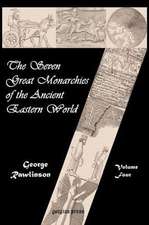Harem: The World Behind the Veil
Autor Alev Lytle Croutieren Limba Engleză Paperback – 29 sep 2014
A fascinating illustrated history of one of the strangest, and cruelest, cultural institutions ever devised. A worldwide best seller, translated into twenty-five languages.
“I was born in a konak (old house), which once was the harem of a pasha,” writes Alev Lytle Croutier. “People around me often whispered things about harems; my own grandmother and her sister had been brought up in one.”
Drawing on a host of firsthand accounts and memoirs, as well as her own family history, Croutier explores life in the world’s harems, from the Middle Ages to the early twentieth century, focusing on the fabled Seraglio of Topkapi Palace as a paradigm for them all. We enter the slave markets and the lavish boudoirs of the sultanas; we witness the daily routines of the odalisques, and of the eunuchs who guarded the harem. Here, too, we learn of the labyrinthine political scheming among the sultan’s wives, his favorites, and the valide sultana—the sultan’s mother—whose power could eclipse that of the sultan himself.
There were the harems of the sultans and the pashas, but there were also “middle-class” harems, the households in which ordinary men and women lived out ordinary—albeit polygamous—lives. Croutier reveals their marital customs, child-rearing practices, and superstitions. Finally, she shows how this Eastern institution invaded the European imagination—in the form of decoration, costume, and art—and how Western ideas, in turn, finally eroded a system that had seemed eternal. Juxtaposing a rich array of illustrations—Western paintings, Turkish and Persian miniatures, family photographs, and even film stills—Croutier demystifies the Western erotic fantasy of “the world behind the veil.” This revised and updated 25th anniversary edition of Harem includes a new introduction by the author, revisiting her subject in light of recent events in Turkey, and the world.
“I was born in a konak (old house), which once was the harem of a pasha,” writes Alev Lytle Croutier. “People around me often whispered things about harems; my own grandmother and her sister had been brought up in one.”
Drawing on a host of firsthand accounts and memoirs, as well as her own family history, Croutier explores life in the world’s harems, from the Middle Ages to the early twentieth century, focusing on the fabled Seraglio of Topkapi Palace as a paradigm for them all. We enter the slave markets and the lavish boudoirs of the sultanas; we witness the daily routines of the odalisques, and of the eunuchs who guarded the harem. Here, too, we learn of the labyrinthine political scheming among the sultan’s wives, his favorites, and the valide sultana—the sultan’s mother—whose power could eclipse that of the sultan himself.
There were the harems of the sultans and the pashas, but there were also “middle-class” harems, the households in which ordinary men and women lived out ordinary—albeit polygamous—lives. Croutier reveals their marital customs, child-rearing practices, and superstitions. Finally, she shows how this Eastern institution invaded the European imagination—in the form of decoration, costume, and art—and how Western ideas, in turn, finally eroded a system that had seemed eternal. Juxtaposing a rich array of illustrations—Western paintings, Turkish and Persian miniatures, family photographs, and even film stills—Croutier demystifies the Western erotic fantasy of “the world behind the veil.” This revised and updated 25th anniversary edition of Harem includes a new introduction by the author, revisiting her subject in light of recent events in Turkey, and the world.
Preț: 154.28 lei
Nou
Puncte Express: 231
Preț estimativ în valută:
29.53€ • 30.71$ • 24.37£
29.53€ • 30.71$ • 24.37£
Carte disponibilă
Livrare economică 22 martie-05 aprilie
Livrare express 08-14 martie pentru 46.43 lei
Preluare comenzi: 021 569.72.76
Specificații
ISBN-13: 9780789212061
ISBN-10: 0789212064
Pagini: 232
Dimensiuni: 178 x 254 x 23 mm
Greutate: 0.89 kg
Ediția:25th Anniversary Edition
Editura: Abbeville Publishing Group
Colecția Abbeville Press
ISBN-10: 0789212064
Pagini: 232
Dimensiuni: 178 x 254 x 23 mm
Greutate: 0.89 kg
Ediția:25th Anniversary Edition
Editura: Abbeville Publishing Group
Colecția Abbeville Press
Cuprins
Table of Contents from Harem: The World Behind the Veil
Harem Revisited
Preface
The Grand Harem
INTRODUCTION - meaning, origins, polygamy, slave markets, harem of Seraglio, acquisition of slaves, training of odalisques, sultanas, eunuchs, dynasty, the Golden Cage, death, the World of extremes
DAILY LIFE IN THE SULTAN'S HAREM - harem walls, gardens, games, pools, riddles and stories, poetry, prayer, secrets of flowers and birds, opium, song and dance, shadow puppets, shopping, excursions, visits and outings, festivals and special days, disenchantment
COSTUME AND FINERY - passing of the veil
THE BATHS
FOODS
SULTANAS - marriage of sultans, harem women and politics, valide procession, princess sultanas, remarriage of sultanas, accouchement and birth, death of sultanas, Roxalena (Hürrem Sultana), Kösem Sultana, Aimée DeBucq de Rivery (Nakshedil Sultana)
EUNUCHS - Süleyman Aga, origins, types of eunuchs, eunuch trade, procedures, Chinese eunuchs, effects of castration, sexual desire and consummation, marriage of eunuchs, regeneration of genitals, the chief black eunuch (kizlar agasi)
Harem Life in the City
ORDINARY HAREMS - the go-betweens, romance, gifts, henna night, weddings, husband-wife relationships, polygamy, relationships among wives, superstition and charms, upkeep, adalisques, jewelry, living quarters, bundle women, death
West Meets East
ORIENTAL DREAM - One Thousand and One Nights, wind from the East, Lady Mary Montagu, journey to the Orient, John Frederick Lewis, the Romantics, Jean-Léon Gérôme and the camera, Amadeo Count Preziosi, Empress Eugénie, Pierre Loti, emancipation of the East, the last picture
SURVIVALS - twentieth-century Orientalist threads, movies and television, harems today
Chronology
Bibliography
Acknowledgements
Index
Harem Revisited
Preface
The Grand Harem
INTRODUCTION - meaning, origins, polygamy, slave markets, harem of Seraglio, acquisition of slaves, training of odalisques, sultanas, eunuchs, dynasty, the Golden Cage, death, the World of extremes
DAILY LIFE IN THE SULTAN'S HAREM - harem walls, gardens, games, pools, riddles and stories, poetry, prayer, secrets of flowers and birds, opium, song and dance, shadow puppets, shopping, excursions, visits and outings, festivals and special days, disenchantment
COSTUME AND FINERY - passing of the veil
THE BATHS
FOODS
SULTANAS - marriage of sultans, harem women and politics, valide procession, princess sultanas, remarriage of sultanas, accouchement and birth, death of sultanas, Roxalena (Hürrem Sultana), Kösem Sultana, Aimée DeBucq de Rivery (Nakshedil Sultana)
EUNUCHS - Süleyman Aga, origins, types of eunuchs, eunuch trade, procedures, Chinese eunuchs, effects of castration, sexual desire and consummation, marriage of eunuchs, regeneration of genitals, the chief black eunuch (kizlar agasi)
Harem Life in the City
ORDINARY HAREMS - the go-betweens, romance, gifts, henna night, weddings, husband-wife relationships, polygamy, relationships among wives, superstition and charms, upkeep, adalisques, jewelry, living quarters, bundle women, death
West Meets East
ORIENTAL DREAM - One Thousand and One Nights, wind from the East, Lady Mary Montagu, journey to the Orient, John Frederick Lewis, the Romantics, Jean-Léon Gérôme and the camera, Amadeo Count Preziosi, Empress Eugénie, Pierre Loti, emancipation of the East, the last picture
SURVIVALS - twentieth-century Orientalist threads, movies and television, harems today
Chronology
Bibliography
Acknowledgements
Index
Recenzii
Praise for Harem: The World Behind the Veil:
“This is a serious history, yet an immensely readable one—informative, gossipy, and grand fun.” —New York Times Book Review
“This beautiful book…stimulates the mind as well as the eye.” —Chicago Sun-Times
"A book of breathtaking beauty, lavishly illustrated with color plates and written in an ingratiating prose." — Washington Post
“An alluring invitation into the labyrinthine corridors of the Turkish harem.” —San Francisco Chronicle
“A delight to the eye but also a poignant statement about the lonely…world of women who lived in virtual slavery.” —Marin Independent Journal
“Croutier’s text, a blend of careful scholarship and gossipy family anecdotes, is richly embellished with documentary photographs and colorful ‘Orientalist’ artwork, depicting harem life.” —Christian Science Monitor
“A gorgeous book that chronicles, in equal measure, the grisly realities of seraglio life and the glowing fictions of Western voyeurism.” —Connoisseur
“A fascinating, colorfully illustrated history of one of humanity’s most bizarre constructs.” —People
“An intriguing text about those all-female worlds in the mysterious East. —Cosmopolitan
“Ms. Croutier has produced an interesting book, an intelligent speculation on the social and psychological influences of this creation.” —The Atlantic
“This is a serious history, yet an immensely readable one—informative, gossipy, and grand fun.” —New York Times Book Review
“This beautiful book…stimulates the mind as well as the eye.” —Chicago Sun-Times
"A book of breathtaking beauty, lavishly illustrated with color plates and written in an ingratiating prose." — Washington Post
“An alluring invitation into the labyrinthine corridors of the Turkish harem.” —San Francisco Chronicle
“A delight to the eye but also a poignant statement about the lonely…world of women who lived in virtual slavery.” —Marin Independent Journal
“Croutier’s text, a blend of careful scholarship and gossipy family anecdotes, is richly embellished with documentary photographs and colorful ‘Orientalist’ artwork, depicting harem life.” —Christian Science Monitor
“A gorgeous book that chronicles, in equal measure, the grisly realities of seraglio life and the glowing fictions of Western voyeurism.” —Connoisseur
“A fascinating, colorfully illustrated history of one of humanity’s most bizarre constructs.” —People
“An intriguing text about those all-female worlds in the mysterious East. —Cosmopolitan
“Ms. Croutier has produced an interesting book, an intelligent speculation on the social and psychological influences of this creation.” —The Atlantic
Notă biografică
Alev Lytle Croutier is the author of Taking the Waters (Abbeville), a history of spas, and three critically acclaimed novels, The Palace of Tears, Seven Houses, and Leyla: The Black Tulip. Born in Turkey, Croutier studied at Oberlin College and founded the publishing company Mercury House.
Extras
Excerpt from Harem: The World Behind the Veil
Preface
These flower women, women-flowers, he prefers them to any others, and spends his nights in the hothouses where he hides them as in a harem.
— Guy de Maupassant, Un Cas de Divorce (1886)
I was born in an old house in Izmir, Turkey, which had previously been inhabited by a pasha who had a harem. I grew up listening to stories that could easily have come from One Thousand and One Nights. People often whispered things about harems; my own grandmother and her sister had been brought up in one. Since then, I have come to see that these were not ordinary stories. But for me, as a child, they were, for I had not yet known any others.
My paternal grandmother, Zehra, was the first person from whom I heard the word harem and who made allusions to harem life. She was the daughter of a prosperous gunpowder maker in Macedonia. As was not uncommon until the twentieth century, she and her sisters had been brought up in a “harem”—which really means a separate part of a house where women lived in isolation, having no contact with men other than their blood relatives. The term does not necessarily imply the practice of polygamy.
Rarely did they go out; and when they did, they were always heavily veiled. The most poignant image I know is that of silk tunnels being stretched from the door of the house to a carriage, so that the ladies could leave without being seen from the street. The family had already arranged their marriages. None of them saw their husbands until their wedding day. Then they moved to his house, to live together with his mother and other women relatives—and occasionally another wife or two.
My grandmother married my grandfather when she was fourteen. He was forty and her father's best friend. She was a simple, uneducated girl from Pirlepe. He was a respected scholar from Kavala. Ten years later, she would be widowed.
Threatened by the Balkan Wars, my grandparents left everything behind in Macedonia, including their parents, and fled to Anatolia. They sought refuge and settled down in Istanbul in 1906. My grandfather soon died, and my grandmother moved in with one of her sisters for a time. The two women brought their children up together, as one family. In 1909, with the fall of Sultan Abdülhamid II, harems were abolished and declared unlawful.
I do not remember very much of the house in Izmir (Smyrna) where I was born. In my memory, it faced the sea and was five stories high. (When I returned years later, I saw that it had only three stories.) It had a hamam where women in the neighborhood came together to bathe. Some of the windows were latticed, screening the outside world. A giant granite rock behind the house isolated it even more. It was said that sometime before us, and old pasha, his two wives, and other women had occupied the place.
When my grandmother, her three sisters, and friends gathered together, they told stories and argued about facts and details, rarely agreeing. We children participated in rituals that the women had transported from their harem days. Like many girls of my generation, we learned to make concoctions to remove hair, brew good coffee, distribute a sacrificed sheep’s entrails to the poor, cast spells, and give the evil eye to protect ourselves.
When I was eighteen years old, I left Turkey and came to live in the United States. Fifteen years later, I returned to Istanbul to visit my family and sort out my impressions of my birthplace. I returned, carrying new baggage with me: an expatriate’s eye and a self-conscious awareness of art history and feminist rhetoric. It was not surprising, then, that I found myself fascinated with the recently restored harem apartments of Topkapi Palace—the Grand Seraglio, or the Sublime Porte, as it was known in the West. It had belonged to the Padishsh, sultans of the Ottoman Dynasty, who had hidden away their women here from around 1540 through the early 1900s—during four hundred years of life and culture. All that remained now of the thousands of women who lived in these rooms, in fantastic luxury and isolation, were their empty boudoirs, they're echoing baths, and countless, impenetrable mysteries.
This visit to the harem of the Topkapi Palace haunted me. I was obsessed with the notion that these same stairways once felt the flying feet; these alleys heard the soft rustle of their garments. The marble floors of the baths were worn out from centuries of water running. The walls seemed to whisper secrets pleading to be heard. Obviously, more was concealed here than the popular notion of sensuality attached to the word harem or what I have learned from art history classes and childhood stories. It seemed as though I had stepped into a unique reality—a cocoon of women in their evolutionary cycle. Questions kept insinuating themselves. Why had we not studied the harem at school? We were taught ten years of Ottoman history and had to memorize the dates of all the wars and conquests and who killed whom. What had occurred here during all these years? Who were these women? What did they do from day to day? Why was it treated so perfunctorily?
I began searching in earnest for documents on harems—books, letters, travelogues, paintings, photographs—to help reconstruct a candid image of this veiled world. What I found were fragments—romanticized descriptions of the imperial harem by Western travelers, writers, or diplomats, a few smuggled letters and poems written by the women themselves, and tedious studies by historians whose primary interest was royal life and palace politics, not the uncounted, unnamed women of the harem.
Simultaneously I had to probe deeper into my own family history. When I expressed my need to find out everything about harems, on which nothing definitive had been written, relatives and friends came forth. They helped me remember things. They showed me strange books and letters. They shared ephemeral stories, things that had happened a long time ago, so that I could write about them.
Physical and spiritual isolation of women and polygamy, I discovered, were not unique to Turkey. Herons existed throughout history and in different parts of the Asian World, known by different names, such as purdah (“curtain”) in India and, in Persia, enderun or zenane. In China, the Forbidden City of Peking also had a cloistered women, protected and guarded by eunuchs.
During the sixth century B.C., King Tamba of Banaras had a harem of some sixteen thousand women. A fifteenth-century sultan of Malwas, Ghiyas-ud-di Khilji, build Jahaz Mahal, the “ship palace,” to accommodate his large harem. Kublai Khan, the Mongol leader, had four empresses and around seven thousand concubines. It is rumored that every two years he would get rid of a couple hundred and replace them with a fresh supply. Emperor Jahangir of India also maintained a harem of six thousand women, as well as a thousand young men-in-waiting for those times when his appetite tended toward the other gender. But the most highly and extensively developed harem was that of the Grand Seraglio. What happened there came to be seen as a paradigm of all harems.
In the Seraglio alone, thousands of women lived and died with only each other to know of their lives. By piecing together the fragments collected over the years, I hope to gain a glimpse into this mysterious, beautiful, and unbelievably repressive world concealed for so many centuries behind the veil. What will these women tell us, about themselves and about ourselves?
Preface
These flower women, women-flowers, he prefers them to any others, and spends his nights in the hothouses where he hides them as in a harem.
— Guy de Maupassant, Un Cas de Divorce (1886)
I was born in an old house in Izmir, Turkey, which had previously been inhabited by a pasha who had a harem. I grew up listening to stories that could easily have come from One Thousand and One Nights. People often whispered things about harems; my own grandmother and her sister had been brought up in one. Since then, I have come to see that these were not ordinary stories. But for me, as a child, they were, for I had not yet known any others.
My paternal grandmother, Zehra, was the first person from whom I heard the word harem and who made allusions to harem life. She was the daughter of a prosperous gunpowder maker in Macedonia. As was not uncommon until the twentieth century, she and her sisters had been brought up in a “harem”—which really means a separate part of a house where women lived in isolation, having no contact with men other than their blood relatives. The term does not necessarily imply the practice of polygamy.
Rarely did they go out; and when they did, they were always heavily veiled. The most poignant image I know is that of silk tunnels being stretched from the door of the house to a carriage, so that the ladies could leave without being seen from the street. The family had already arranged their marriages. None of them saw their husbands until their wedding day. Then they moved to his house, to live together with his mother and other women relatives—and occasionally another wife or two.
My grandmother married my grandfather when she was fourteen. He was forty and her father's best friend. She was a simple, uneducated girl from Pirlepe. He was a respected scholar from Kavala. Ten years later, she would be widowed.
Threatened by the Balkan Wars, my grandparents left everything behind in Macedonia, including their parents, and fled to Anatolia. They sought refuge and settled down in Istanbul in 1906. My grandfather soon died, and my grandmother moved in with one of her sisters for a time. The two women brought their children up together, as one family. In 1909, with the fall of Sultan Abdülhamid II, harems were abolished and declared unlawful.
I do not remember very much of the house in Izmir (Smyrna) where I was born. In my memory, it faced the sea and was five stories high. (When I returned years later, I saw that it had only three stories.) It had a hamam where women in the neighborhood came together to bathe. Some of the windows were latticed, screening the outside world. A giant granite rock behind the house isolated it even more. It was said that sometime before us, and old pasha, his two wives, and other women had occupied the place.
When my grandmother, her three sisters, and friends gathered together, they told stories and argued about facts and details, rarely agreeing. We children participated in rituals that the women had transported from their harem days. Like many girls of my generation, we learned to make concoctions to remove hair, brew good coffee, distribute a sacrificed sheep’s entrails to the poor, cast spells, and give the evil eye to protect ourselves.
When I was eighteen years old, I left Turkey and came to live in the United States. Fifteen years later, I returned to Istanbul to visit my family and sort out my impressions of my birthplace. I returned, carrying new baggage with me: an expatriate’s eye and a self-conscious awareness of art history and feminist rhetoric. It was not surprising, then, that I found myself fascinated with the recently restored harem apartments of Topkapi Palace—the Grand Seraglio, or the Sublime Porte, as it was known in the West. It had belonged to the Padishsh, sultans of the Ottoman Dynasty, who had hidden away their women here from around 1540 through the early 1900s—during four hundred years of life and culture. All that remained now of the thousands of women who lived in these rooms, in fantastic luxury and isolation, were their empty boudoirs, they're echoing baths, and countless, impenetrable mysteries.
This visit to the harem of the Topkapi Palace haunted me. I was obsessed with the notion that these same stairways once felt the flying feet; these alleys heard the soft rustle of their garments. The marble floors of the baths were worn out from centuries of water running. The walls seemed to whisper secrets pleading to be heard. Obviously, more was concealed here than the popular notion of sensuality attached to the word harem or what I have learned from art history classes and childhood stories. It seemed as though I had stepped into a unique reality—a cocoon of women in their evolutionary cycle. Questions kept insinuating themselves. Why had we not studied the harem at school? We were taught ten years of Ottoman history and had to memorize the dates of all the wars and conquests and who killed whom. What had occurred here during all these years? Who were these women? What did they do from day to day? Why was it treated so perfunctorily?
I began searching in earnest for documents on harems—books, letters, travelogues, paintings, photographs—to help reconstruct a candid image of this veiled world. What I found were fragments—romanticized descriptions of the imperial harem by Western travelers, writers, or diplomats, a few smuggled letters and poems written by the women themselves, and tedious studies by historians whose primary interest was royal life and palace politics, not the uncounted, unnamed women of the harem.
Simultaneously I had to probe deeper into my own family history. When I expressed my need to find out everything about harems, on which nothing definitive had been written, relatives and friends came forth. They helped me remember things. They showed me strange books and letters. They shared ephemeral stories, things that had happened a long time ago, so that I could write about them.
Physical and spiritual isolation of women and polygamy, I discovered, were not unique to Turkey. Herons existed throughout history and in different parts of the Asian World, known by different names, such as purdah (“curtain”) in India and, in Persia, enderun or zenane. In China, the Forbidden City of Peking also had a cloistered women, protected and guarded by eunuchs.
During the sixth century B.C., King Tamba of Banaras had a harem of some sixteen thousand women. A fifteenth-century sultan of Malwas, Ghiyas-ud-di Khilji, build Jahaz Mahal, the “ship palace,” to accommodate his large harem. Kublai Khan, the Mongol leader, had four empresses and around seven thousand concubines. It is rumored that every two years he would get rid of a couple hundred and replace them with a fresh supply. Emperor Jahangir of India also maintained a harem of six thousand women, as well as a thousand young men-in-waiting for those times when his appetite tended toward the other gender. But the most highly and extensively developed harem was that of the Grand Seraglio. What happened there came to be seen as a paradigm of all harems.
In the Seraglio alone, thousands of women lived and died with only each other to know of their lives. By piecing together the fragments collected over the years, I hope to gain a glimpse into this mysterious, beautiful, and unbelievably repressive world concealed for so many centuries behind the veil. What will these women tell us, about themselves and about ourselves?

























